Wisteria bonsai care
Wisteria bonsai care at a glance
| Cold tolerance | Strong |
| Heat tolerance | Strong |
| Drought tolerance | Fairly low |
| Sun exposure | Full sun |
| Soil mix | Akadama/volcanic sand: 60% Pumice: 30% Organic compost: 10% |
| Watering | 1-2 /day in spring and fall 2-3 times/day in summer Once every 3-4 days in winter |
Choosing the right wisteria variety

Selecting the perfect wisteria variety is a crucial first step in your journey to cultivating a stunning wisteria bonsai. Each wisteria variety has unique characteristics that contribute to the beauty of your bonsai creation.
Among 4 species of wisteria, I recommend choosing Japanese Wisteria for making a bonsai. One of the most compelling reasons is its exquisite and fragrant flower clusters that bloom in a variety of colors.
Also, Japanese wisteria has long been cultivated as bonsai species with a lot of growing experiences accumulated. This makes creating Japanese wisteria into bonsai less complicated in terms of growing and styling.
For more about the best wisteria for bonsai, the following article may be helpful.
Placing

Wisteria is a sun-loving plant and prefers full sun. Look for a place where your bonsai gets at least 6 hours of direct sunlight each day, especially during the growing season. This is not only necessary to produce flower buds but also to make shorter internodes.
Keep in mind that wisteria bonsai prefer moderate temperatures between 68°F to 77°F (20°C to 25°C) for the development of flower buds. Avoid prolonged exposure to extreme heat in summer.
Repotting

How often to repot
When young, repot your wisteria bonsai every year to encourage root development and establishment. As your bonsai matures, you can repot every other year to keep them in good shape.
Keep in mind that frequent repotting can result in vigorous root growth and thus abundant foliage, which might negatively affect the quality of flowers.
When to repot
The best time to repot a wisteria bonsai is right after blooming if want to enjoy flowers. You can also repot in early spring when the buds are just beginning to emerge but it may damage flower buds.
Best soil mix for wisteria bonsai
The best soil mix for wisteria bonsai is;
- Akadama/volcanic sand: 60%
- Pumice: 30%
- Organic compost: 10%
The soil should have good water retention as well as drainage.
How to repot
Step 1
Pull the tree out of the pot and loosen the old soil, first from the bottom and then from around the edges.
Step 2
Prune thick/old roots while avoiding cutting fine roots. When uncertain, I would advise to exercise caution and avoid drastic root pruning.
While wisteria roots grow robustly, excessive pruning may lead to diminished flowering and a significant decline in the tree’s vitality. This is because bean family plants like wisteria absorb nitrogen from the air with the help of bacteria in their roots. So, cutting a large part of the roots may not be a good idea.
Step 3
Put a layer of large grain soil (eg. pumice) on the bottom of the pot for drainage. Choose a deeper pot (as a bonsai pot) taking into account the drooping flowers and the vines.
Step 4
Place the tree in the pot and fill it with soil mix.
After repotting, water well and move the tree to a shaded place with little wind for 1 to 2 weeks until it takes root. During this time, make sure not to let the soil dry out, and water it before it completely dries out.
Watering
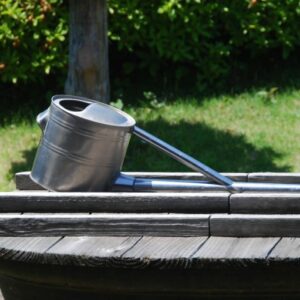
As a general guide, wisteria bonsai should be watered;
-
- Once to twice/day in spring and fall
- Twice or three times/day in summer
- Once every 3 to 4 days in winter
Wisteria loves water, which dries out pretty quickly. In my experience, it feels like wisteria bonsai soil dries twice as quickly as other deciduous trees like Japanese maple or zelkova.
Wisteria roots start to rot when the soil is dry, so it’s important to keep the soil moist, especially during hot weather.
If you can’t water your bonsai during the day, fill a dish or plate with water and sit the pot’s bottom in it. Just be careful not to make all the soil too wet all the time. Water only when the soil feels dry.
To be safe, remove the pot from the plate with water and let the soil dry out two to three times a week, maybe on weekends. This way, the soil has a chance to adequately dry out for the roots to respirate.
The key takeaway here is to find the right balance: underwatering is bad but overwatering is also bad.
Fertilizing
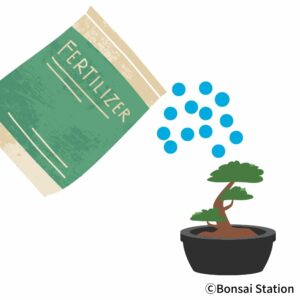
Fertilization is very important for the successful blooming of wisteria bonsai. Wisteria needs lots of fertilizer, and one of the secrets to getting a lot of flowers is to use fertilizer well during the growing season.
When to fertilize
Spring
Right after the flowers bloom in spring, give your wisteria bonsai plenty of fertilizer as it used up most of the nutrients in itself and in the soil for blooming. Next year’s bloom depends on the nutrients given for about a month and a half after the flowers bloom.
Be cautious not to feed your wisteria bonsai with too much nitrogen as wisteria flower buds start to emerge right after the flowers bloom. Abundant nitrogen tends to promote foliage growth over flower buds. Put emphasis on phosphorous and potassium rather than nitrogen.
If you repot right after blooming, you do not have to wait to fertilize but it’s better to start with a diluted liquid fertilizer to be safe.
Summer
Stop fertilizing during summer as your bonsai doesn’t absorb as much nutrients when it is hot.
Fall
Start fertilizing again from late August until October to get your bonsai ready for winter dormancy.
Winter
You don’t need to fertilize during winter as your bonsai is dormant.
Which fertilizer to use
For optimum bloom
Choose a fertilizer with a higher middle and last number in the N-P-K ratio, indicating a significant phosphorus and potassium content. The following product from Amazon is a slow-release bonsai bloom fertilizer with an N-P-K ratio of 6-8-10 and is perfect for your wisteria bonsai.
You don’t need nitrogen-rich fertilizer for wisteria bonsai. As a bean family tree, wisteria can take in nitrogen from the air with the help of bacteria in its roots. So, wisteria bonsai has a relatively lower requirement for additional nitrogen fertilization compared to trees that lack this nitrogen-fixing ability.
For treating yellowing leaves
If you notice yellowing leaves during the growing season, provide your wisteria with calcium and magnesium. For this, dolomite lime is the best because it is a natural rock that contains high levels of calcium and magnesium.
Dolomite Lime Soil Amendment Fertilizer
Make sure to read the label and not give too much of it. Excess calcium can prevent the tree from absorbing other essential nutrients like magnesium, potassium, and phosphate.
Pinching and pruning

Deadheading
Just after blooming and before fruiting beans, remove spent flowers leaving an inch (2cm) stem (this process is called “deadheading”). This is to encourage focusing the tree’s energy on producing new flower and leaf buds rather than reproduction. They are formed at the point where a leaf/flower joins the stem.
Pinching/pruning
Early summer
If you have matured and established wisteria bonsai, prune or pinch vines, leaving 2 to 3 nodes in early summer. You do not have to prune weak vines. These need to be left to accumulate energy for bud formation.
Do not do this for younger trees. It will encourage more vine growth rather than flower bud growth.
When you see excessively strong vines, prune them to encourage the growth of new branches with shorter internodes. Strong wisteria vines can have 20 smaller leaflets attached to them. These long leafy vines usually do not produce flower buds.
The strong vines can also deform the shape of your bonsai if they are left to grow. Pruning them helps maintain the balanced and aesthetic form of the bonsai.
Fall
If you have younger trees and waited for vines to grow, it is time to prune in fall, leaving 2 to 3 nodes.
Late fall/ Winter
Pruning for styling wisteria bonsai should be done just before it enters its dormant phase. If you’ve done pinching/pruning during the growing season, you might not need pruning at this time.

Wisteria flower bud: rounder and looks swollen
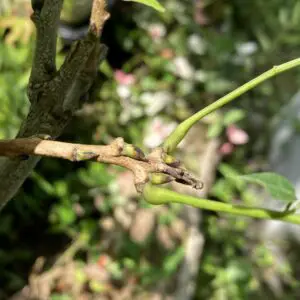
Wisteria leaf bud: elongated and pointy
At this point, it’s easy to tell apart the flower buds from the leaf buds. Wisteria flower buds are usually larger and rounder whereas wisteria leaf buds are smaller and more elongated in shape. Avoid cutting flower buds and trim any unnecessary or overgrown branches.
Wiring
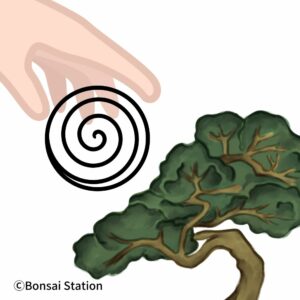
Wisteria bonsai usually do not need wiring because they naturally grow into well-shaped bonsai with proper pruning, without artificial shaping. But if pruning isn’t enough, the best time for wiring wisteria bonsai is around April when new shoots emerge in spring.
When you need to do hard wiring, wrap raffia or similar material around the bend to keep those parts safe. After wiring, let the bonsai sit in a shaded area with minimal wind for about a week. Remember to remove the wire after a year.
Blooming care
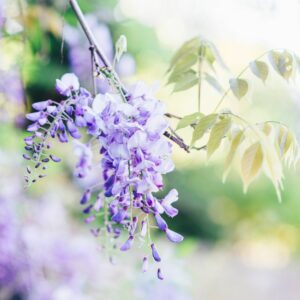
To ensure your wisteria bonsai produces abundant and vibrant flowers, it’s important to provide the right care and attention.
- Give the right fertilizer: Emphasize phosphorous and potassium and less nitrogen.
- Place outside under full sun all day
- Maintain a moderate temperature range: Between 68°F to 77°F (20°C to 25°C) is best for flower bud development.
- Avoid pruning in summer: Flower and leaf buds are not always discernible.
- Provide adequate watering: Avoid water shortage.
For more detailed information about blooming wisteria bonsai, I wrote the following article about it which might be helpful.
Infestation

Prevention
Protecting your wisteria bonsai from pests and diseases is essential to maintaining its health and vitality. For this, prevention is the key; it is way easier than treating or eradicating pests/diseases once they occur.
Check and monitor your trees regularly. Make sure to look at them from all directions. Provide them with the optimal location and environment. And when acquiring new trees, quarantine them for a period to prevent introducing pests or diseases to your other bonsai trees.
Common wisteria pests
Common wisteria pests include aphids, scale insects and caterpillars. Caterpillars can eat up all the leaves instantly if you do not catch them at the right moment.
How to treat wisteria pests
Here are 3 steps to get rid of bugs on your wisteria bonsai trees:
-
- Identify bugs
- Use non-chemical options
- Use chemical options
Identify bugs
Familiarize yourself with the common pests that affect wisteria bonsai trees in your area. This will help you identify any pests you may encounter.
Non-chemical options
Before using chemicals, there are non-chemical options you can take, including taking them out by hand and pruning affected areas, to get rid of bugs on your bonsai trees. These are easy to do and do no harm to your bonsai trees.
Chemical options
As a chemical option, I would recommend using neem oil for eradicating pests. Neem is a tree native to the Indian subcontinent, which acts as an insect repellent and growth inhibitor. Neem oil is safe for plants as well as humans and works perfectly for my bonsai trees.
Common wisteria diseases
Common wisteria diseases include powdery mildew and canker diseases.
How to treat wisteria diseases
Here are 3 steps to treat diseases on bonsai trees.
- Identify the disease
- Use non-chemical options
- Use chemical options
Identify the disease
Look for the symptoms of the tree and do research on wisteria diseases. Common symptoms include discoloration of leaves, wilting, deformation, cankers, or abnormal growth.
Use non-chemical options
Remove the infested parts carefully using a sterile tool. This may include leaves, branches, or even a part of the trunk if the disease has progressed too far. Do not use your hands because you may touch other trees later, risking the disease to spread.
Use chemical options
Neem oil has antifungal and antibacterial properties that can help control certain bonsai diseases.
If neem oil does not work, identify the problem and choose the right product that can treat the disease. There are many different types of fungicides and bactericides available in the market but not all of them work for the problem with your bonsai.
If you are interested in preventing or treating pests and diseases, please read the following article. It is a complete guide that can help you.
Caring in extreme weather

Wisteria is cold- and heat-tolerant but there are occasions where it might need protection.
On the cold side, wisteria flower and leaf buds can tolerate up to -4°F (-20°C). But with cold/dry wind, they may be damaged. If the temperature is coming down to this level, provide your bonsai with frost protection by covering it with a frost cloth or bring them to a shed.
During heatwaves, shield your wisteria bonsai from intense sunlight by providing shade to prevent heat stress. Wisteria bonsai is prone to water shortages and the heat stress may damage flower buds for the next year.




